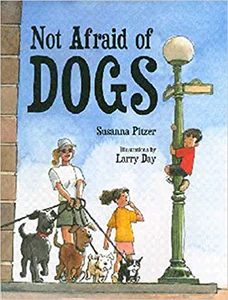Not Afraid of Dogs

Recommended Age Range: Preschool through 2nd grade.
Publisher's Summary:
Daniel is the bravest boy of all! Daniel isn’t afraid of spiders. He isn’t afraid of snakes. He isn’t even afraid of thunderstorms. And no matter what his sister says, he’s certainly not afraid of dogs ― he just doesn’t like them. But there’s no avoiding them when he comes home and his mother is babysitting his aunt’s dog.

Dr. Annie's Takeaways
Recommended for: This book could open up some important conversations about fears and bravery with children who are holding beliefs that they shouldn’t be scared or that others will judge them if they are. It is also an extremely sweet book about a boy overcoming his fear of dogs to comfort a dog when she is scared. I would not recommend this book for a child who isn’t expressing some embarrassment/shame/denial of their anxiety, as this could introduce the idea that someone might make fun of them for their fear (it’s not that this book is endorsing this, but it’s part of the plot).
Would a child like it? A child who has some ambivalence about their own anxiety and bravery would likely connect with this story. It has a sweet, empowering ending that many children would enjoy.
Evidence-Based Practices:
Exposure
Tone: Emotionally resonant, deep, sweet
Story Quality: This book really has a lot of depth and character development for a 32-page picture book. It starts out with what I’m going to label as culturally-normative toxic masculinity–Daniel prides himself in being brave (which he mistakenly defines as not being afraid of things other people are afraid of, like snakes and thunderstorms), and he denies his fear of dogs. He has a taunting little sister who reinforces Daniel’s belief that it’s bad to be afraid (she calls him a scaredy cat). After a run-in with a very scared dog, Daniel realizes that the dog isn’t scary; she’s scared (of a thunderstorm), and she needs him to comfort her. It’s such a sweet, compassionate ending that shows the reader what real bravery looks like.
Illustrations: Watercolor illustrations that look a bit old-fashioned. Importantly, the dog is cute.
Representation: Daniel and his family are White. Daniel has a mother, father, and sister. They live in an apartment building in a city.
Psychological Practices: This story could start a conversation about why Daniel is denying that he is afraid of dogs when the reader can tell that he is (e.g., fear of being teased, gendered expectations about being afraid, misconceptions of bravery). It also introduces a perspective-taking skill–Daniel realizes that he is afraid of the dog, and the dog is afraid of the thunderstorm. When he realizes that the dog needs comforting, he braves his fears and comforts her, and then realizes that she isn’t actually scary.
Concerns: I would never recommend that anyone call anyone a “scaredy cat,” of course. The world doesn’t need any more stigma or shame around anxiety.
